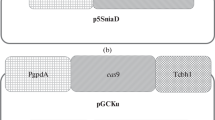Abstract.
The Pseudonocardiaceae Amycolatopsis sp. strain HR167 is used in a biotransformation process to produce vanillin from ferulic acid. To make this strain accessible for genetic engineering, a direct mycelium transformation system developed for Amycolatopsis mediterranei [Madon and Hütter (1991) J Bacteriol 173:6325–6331] was applied and optimized for Amycolatopsis sp. strain HR167. The physiological state of the cells had a major influence on the transformation rate. The highest transformation rate of about 7×105 transformants per microgram of DNA was obtained with mycelium harvested 6.5–7.5 h after the culture has reached the stationary growth phase. When cells were harvested outside of this time slot, the transformation rate drastically decreased. The density of the mycelium suspensions used in the transformation mixture and the methylation state of the plasmid DNA used for the transformation were also crucial parameters. With plasmid DNA isolated from Escherichia coli ET12567, transformation rates were 3,500-fold higher than those obtained with DNA isolated from E. coli XL1-Blue.
Similar content being viewed by others
Author information
Authors and Affiliations
Additional information
Electronic Publication
Rights and permissions
About this article
Cite this article
Priefert, .H., Achterholt, .S. & Steinbüchel, .A. Transformation of the Pseudonocardiaceae Amycolatopsis sp. strain HR167 is highly dependent on the physiological state of the cells. Appl Microbiol Biotechnol 58, 454–460 (2002). https://doi.org/10.1007/s00253-001-0920-5
Received:
Revised:
Accepted:
Issue Date:
DOI: https://doi.org/10.1007/s00253-001-0920-5




